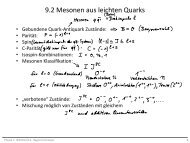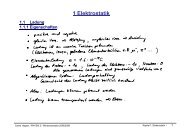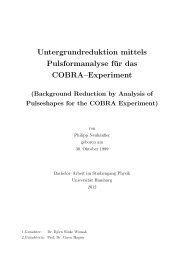Setup of a Drift Tube Muon Tracker and Calibration of Muon ...
Setup of a Drift Tube Muon Tracker and Calibration of Muon ...
Setup of a Drift Tube Muon Tracker and Calibration of Muon ...
Create successful ePaper yourself
Turn your PDF publications into a flip-book with our unique Google optimized e-Paper software.
counts/days*4 hitsDay (Red) <strong>and</strong> Night (Blue) spectrum21.81.61.41.210.80.60.40.2200 300 400 500 600nhitsFigure 4.8: Day <strong>and</strong> night spectra for the energy region outside the 210 Po peak. Nosignificant difference between the spectra is observed. Figure from [73].4.4.2 8 B NeutrinosSpectroscopic measurements <strong>of</strong> solar 8 B neutrinos have been done previously byKamiok<strong>and</strong>e [11] <strong>and</strong> Super-Kamiok<strong>and</strong>e [31] using a water Čerenkov detector <strong>and</strong>SNO [74] using deuterium as a target, all with an energy threshold <strong>of</strong> ∼ 5MeV orhigher. Recently, the SNO collaboration published an analysis with a threshold <strong>of</strong>3.5 MeV [29].Borexino is the first experiment succeeding in spectroscopic measurements <strong>of</strong>the 8 B neutrino flux using liquid scintillator. All major backgrounds above the2.614 MeV gamma from the decay <strong>of</strong> 208 Tl could be reduced sufficiently allowingto set the energy threshold for the 8 B neutrinos as low as 3MeV [75]. Taking intoaccount the 7 Be neutrino measurements described in the previous section, Borexinois the first experiment where neutrinos from both pp-chain reactions have beeninvestigated simultaneously. Very interestingly, the energy region <strong>of</strong> those neutrinoscovers the transition region from vacuum to matter dominated oscillations inthe LMA solution <strong>of</strong> the MSW effect described in Section 2.2.2, thus providing anexcellent method to experimentally challenge this prediction.Two different analyses were done for the 8 B neutrinos, one with a threshold <strong>of</strong>3MeV <strong>and</strong> another one with a higher threshold at 5 MeV to be able to compare theresults with earlier measurements from Super-Kamiok<strong>and</strong>e <strong>and</strong> SNO. Recent resultsare based on 488 days <strong>of</strong> data taking, with a total exposure time after cuts <strong>of</strong> 345.3days in a fiducial target volume <strong>of</strong> 100 tons.8 B neutrinos were selected from data through the application <strong>of</strong> a set <strong>of</strong> cutsdescribed in [75]. An interaction rate <strong>of</strong> 0.217 ± 0.038 stat ± 0.008 syst counts per day<strong>and</strong> 100 tons was found for an energy threshold <strong>of</strong> 3 MeV. Raising this threshold to+0.0085MeV, 0.134 ±0.022 stat counts per day <strong>and</strong> 100 tons remain. Fig. 4.9 shows−0.007systthe 8 B neutrino energy spectrum for the selected data. It is consistent with thehigh metallicity SSM BPS09(GS98) model presented in Section 2.3 in combination64





